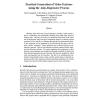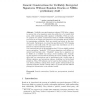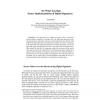120
Voted
CCS
2010
ACM
15 years 29 days ago
2010
ACM
An aggregate signature scheme is a digital signature scheme where anyone given n signatures on n messages from n users can aggregate all these signatures into a single short signa...
ICISC
2001
15 years 2 months ago
2001
In this paper, we propose a multi-signature scheme, in which each signer can express her intention associating with the message to be signed. Signers' intentions mean a kind o...
94
Voted
ICONIP
2004
15 years 2 months ago
2004
Abstract. A signature verification algorithm based on static and dynamic features of online signature data is presented. Texture and topological features are the static features of...
116
click to vote
ICISC
2004
15 years 2 months ago
2004
An identity (ID)-based signature scheme allows any pair of users to verify each other's signatures without exchanging public key certificates. With the advent of Bilinear maps...
118
click to vote
BIOID
2008
15 years 2 months ago
2008
Abstract. Security and privacy issues are considered as two of the major concerns related to the use of biometric data for authentication purposes. In this paper we propose two dif...
109
click to vote
BMVC
2002
15 years 3 months ago
2002
Recently, there have been several attempts at creating `video textures', that is, synthesising new (potentially infinitely long) video clips based on existing ones. One way t...
106
click to vote
ACNS
2010
Springer
15 years 4 months ago
2010
Springer
Verifiably encrypted signature schemes (VES) allow a signer to encrypt his or her signature under the public key of a trusted third party, while maintaining public signature verifi...
83
Voted
ISN
1998
Springer
15 years 4 months ago
1998
Springer
An expectation of a signature system is that a signatory cannot dispute a signature. Aiming at this, the following questions arise: Can documents in electronic commerce on the Inte...
115
click to vote
ETRICS
2006
15 years 4 months ago
2006
Abstract. Most intrusion detection systems deployed today apply misuse detection as detection procedure. Misuse detection compares the recorded audit data with predefined patterns,...
105
click to vote
CRYPTO
2006
Springer
15 years 4 months ago
2006
Springer
In a traditional signature scheme, a signature on a message m is issued under a public key PK, and can be interpreted as follows: "The owner of the public key PK and its corr...



